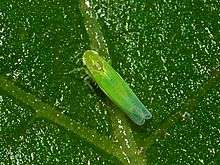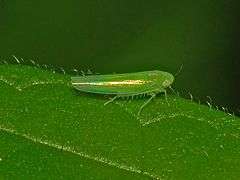Empoasca decipiens
| Empoasca decipiens | |
|---|---|
 | |
| Empoasca cf. decipiens | |
| Scientific classification | |
| Kingdom: | Animalia |
| Phylum: | Arthropoda |
| Subphylum: | Hexapoda |
| Class: | Insecta |
| Order: | Hemiptera |
| Suborder: | Auchenorrhyncha |
| Infraorder: | Cicadomorpha |
| Superfamily: | Membracoidea |
| Family: | Cicadellidae |
| Subfamily: | Typhlocybinae |
| Tribe: | Empoascini |
| Genus: | Empoasca |
| Species: | E. decipiens |
| Binomial name | |
| Empoasca decipiens Paoli, 1930 | |
Empoasca decipiens is a species of "leafhoppers" belonging to the family Cicadellidae subfamily Typhlocybinae.
This quite common species is present in most of Europe, in eastern Palearctic ecozone, in North Africa, in the Near East, and in the 'Afro-tropical ecozone'.

The adults reach 3–4 millimetres (0.12–0.16 in) of length. The basic coloration of the body is light green, with pale blue hyaline forewings. They are perfectly fit to fly, but often they prefer to jump away. Adult leafhoppers can mostly be encountered from June through December on the undersides of leaves in low vegetation.
Both nymphs and adults of this small insect is considered a very destructive pests on field crops and vegetables crops grown in greenhouses. They have a very broad host plants range, mainly broad bean (Vicia faba), green bean (Phaseolus vulgaris), pea (Pisum sativum), potato (Solanum tuberosum), tomato (Solanum lycopersicum), aubergine (Solanum melongena) and cucumber (Cucumis sativus), as well as sugar beet (Beta vulgaris) and cotton (genus Gossypium).
They may have up to ten generations per year, depending on temperature and areas of development. In the five nymphal instars the nymphs are very similar to the adults, but they lack wings until the fourth instar. This species may overwinter as adult on wintergreen plants.
Subspecies
- Empoasca decipiens minutissima Vilbaste, 1961
References
- Anufriev G. A. - The genus Empoasca Walsh, 1864 (Homoptera, Cicadellidae, Typhlocybinae) in the Soviet Maritime Territory // Ann. zool. 1973. T. 30, N 18. P. 537—558.
- Dworakowska I. Kybos Fieb. - Subgenus of Empoasca Walsh (Auchenorrhyncha, Cicadellidae, Typhlocybinae) in Palaearctic. //Acta zool. crac. 1976. T. 21. N 13. P. 387—463
- Mahmoud, Y.A., Amr, E.M. and Ebadah, I.M.A. - Some Ecological Behaviors of the Leafhopper, Empoasca decipiens (Paoli) on Some Winter Plantations in Egypt - J. Basic. Appl. Sci. Res., 1(2)88-94, 2011